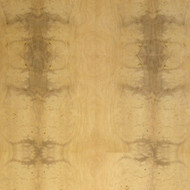What is Myrtle Burl
Mar 13th 2025
Myrtle Burl wood is a highly decorative and prized type of wood that comes from burl formations on the Myrtle tree (Umbellularia californica), also known as California Bay Laurel or Oregon Myrtle. This tree is native to the coastal regions of Oregon and Northern California. Myrtle Burl is celebrated for its unique grain patterns, vibrant colors, and versatility, making it a favorite among artisans, woodworkers, and furniture makers.
Characteristics of Myrtle Burl Wood:
- Grain Patterns:
- Myrtle Burl features intricate and chaotic grain patterns, including swirls, waves, and clusters of "eyes."
- These patterns create a highly decorative and unique visual appeal.
- Color:
- Myrtle Burl displays a wide range of colors, from golden yellows and warm browns to rich olive and even subtle grays or purples.
- The variety of hues and natural luster make it particularly striking.
- Texture:
- Fine and smooth, with a natural sheen that enhances its visual impact when polished.
- Takes finishes exceptionally well, resulting in a luxurious surface.
- Durability:
- Myrtle Burl is relatively hard and dense, making it durable for a variety of applications.
- Its irregular grain can make it prone to splitting or cracking, so careful handling is required.
- Rarity:
- Burl formations on Myrtle trees are uncommon, and the limited range of the species makes Myrtle Burl wood relatively rare and valuable.
Uses of Myrtle Burl Wood:
- Furniture and Veneers:
- Often used for veneers to create high-end furniture, including tables, cabinets, and decorative panels.
- Adds elegance and sophistication to interiors.
- Woodturning:
- Popular for crafting bowls, vases, and other turned items that showcase its complex grain patterns.
- Luxury Items:
- Used to create high-end pens, knife handles, jewelry boxes, and other small decorative pieces.
- Musical Instruments:
- Occasionally used as a decorative facing for guitars and other instruments.
- Artistic Projects:
- Favored by artists for sculptures, plaques, and custom designs due to its unique appearance.
Challenges:
- Workability:
- The irregular grain can make Myrtle Burl challenging to cut, sand, and shape, with a risk of tear-out or chipping.
- Stabilization (e.g., resin infusion) is often used for pieces with cracks or voids.
- Cost:
- Due to its rarity and stunning aesthetics, Myrtle Burl wood is more expensive than standard Myrtle wood or other common burls.
